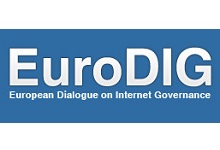The domain name system: How it works
8 Jun 2018 02:00h
Event report
This educational track provided basic training on how the Domain Name System (DNS) works, by explaining who governs it and how it operates, and why it is important for the wider debates in the Internet governance ecosystem.
The session was led by Mr Peter Van Roste (General Manager at the Council of European National Top-Level Domain Registries, (CENTR)) and Ms Alexandrine Gauvin (Communications Manager, CENTR).
Gauvin introduced CENTR as a forum for information exchange and dialogue among the country code top-level domain name (ccTLD) registries in Europe. Education and raising awareness about the DNS are important aspects of CENTR’s work. She began the session by noting that the Internet is governed by the multistakeholder approach which gathers input from businesses, civil society, governments, research institutions, and non-governmental organisations.
Van Roste started off by explaining how data traffic travels along the network. Every device has an Internet Protocol (IP) address which is assigned to the it. The Public Technical Identifiers (PTI), which is part of the Internet Corporation for Assigned Names and Numbers (ICANN), manages the IP addresses globally, and allocates address pools to Regional Internet Registries (RIRs). The regional address pool in Europe is coordinated by the RIPE Network Coordination Centre (RIPE NCC). Van Roste further explained the difference between a static IP and a dynamic one (every device gets a new IP address when it connects to the network). He also noted the different IP versions now in use: IP version 4 (IPv4) and IP version 6 (IPv6). Since there is only a scarce number of IP addresses that can be assigned, the newer version provides for more combinations and thus for more devices to be online. However, the older IPv4 is still more used globally than the IPv6.
Van Roste further explained the concept of top-level domains (TLDs) and the two main types: ccTLDs, such as .de for Germany or .ge for Georgia, which are managed locally and serve local communities; Generic top-level domains (gTLDs), such as .com or .org, which are managed by registries on the basis of contracts concluded with ICANN.
Several main characteristics of the DNS were mentioned – decentralisation, hierarchy, stability, and layers. The DNS is hierarchical as it is organised in several layers that communicate with each other. For example, we have the rootzone maintainer (ex. PTI), the relevant TLD and its registry and registrars (ex. .eu and the EURid registry), and on the last level, the domain name registrant (ex. the European Commission as a domain name registrant for ec.europa.eu ).
Van Roste expressed his support for the ICANN multistakeholder model, in which every stakeholder group has a voice. Reference was made to the so-called ‘Internet Assigned Names Authority (IANA) stewardship transition’, a process that led to the creation of a multistakeholder oversight model for the PTI (as opposed to the previous model in which ICANN managed the DNS on the basis of a contract with the US government).
It was also noted that the founding fathers of the Internet established the technical layer in such a way that neither a single organisation such as ICANN, nor the multistakeholder model, would decide about country codes. When it comes to the allocation of country codes to countries or territories, ICANN follows decisions takes at the United Nations level, and does not decide itself what constitute a country or a territory.
The two last points of the education track highlighted that most users globally do not know how this vital Internet component works, since it has for the last 30 years worked seamlessly. There was also a discussion on the practice of DNS blocking as a content policy measure. For example, in case of a court order or a governmental decision to prohibit access to certain websites, Internet Service Providers (ISPs) are asked to re-direct users from the blocked websites to other webpage indicating the reason for the blocked access. This practice cannot fully stop users from finding another way to access those websites, but it can cause distrust in the DNS and Internet services. This is why DNS blocking is not a proper solution and should only be used as a last resort mechanism, it was argued. The DNS relies on the trust of the users, and Van Roste invited the audience to learn more about this core component which makes the Internet as we know it today.
Related topics
Related event

